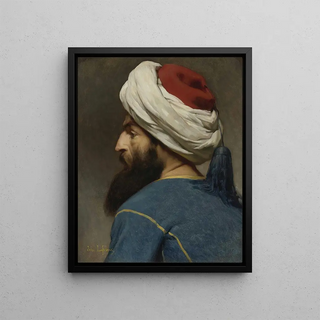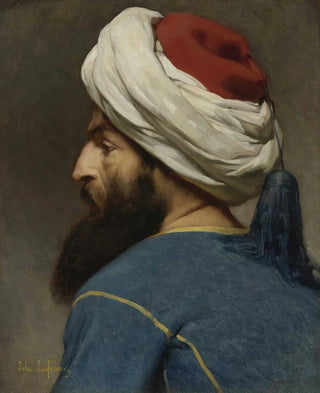Art print | Portrait of an Ottoman - Jules Joseph Lefebvre


View from behind

Frame (optional)
Portrait of an Ottoman - Jules Joseph Lefebvre – Captivating Introduction
The "Portrait of an Ottoman" by Jules Joseph Lefebvre is a work that transports the viewer to a time when Orientalism fascinated European artists. Painted at the end of the 19th century, this canvas evokes not only the aesthetic beauty of a character but also a rich blend of cultures and influences. Lefebvre, through his talent, manages to capture the very essence of his model while reflecting a romanticized and idealized vision of the Orient. This portrait, both vibrant and mysterious, invites an exploration of the subtleties of identity, status, and representation.
Style and uniqueness of the work
Lefebvre's style is distinguished by his mastery of colors and textures. In this portrait, the warm nuances of the character's clothing contrast with the background, creating a visual depth that draws the eye. The light, skillfully orchestrated, highlights the delicate features of the Ottoman's face while emphasizing the richness of the ornaments surrounding him. Lefebvre uses brushstrokes that evoke both the academic tradition and a more free, almost impressionist approach, particularly visible in the details of the drapery. This blend makes the work both timeless and rooted in a historical reality, captivating the viewer and inviting reflection on the life of this man beyond the canvas.
The artist and his influence
Jules Joseph Lefebvre, born in 1836, was a French painter renowned for his portraits and still lifes. Trained at the École des Beaux-Arts in Paris, he quickly developed a style that was uniquely his own, blending classical influences with contemporary trends. Lefebvre was also an influential teacher, passing on his knowledge to many students, some of whom became renowned artists. His interest in Orientalism is evident in several of his works, where he seeks to depict the beauty and complexity of Eastern cultures. By choosing to paint an Ottoman, Lefebvre participated in an artistic movement that, although idealized, opened a window onto the richness of cultural exchanges between the East and the West. His work has

Matte finish

View from behind

Frame (optional)
Portrait of an Ottoman - Jules Joseph Lefebvre – Captivating Introduction
The "Portrait of an Ottoman" by Jules Joseph Lefebvre is a work that transports the viewer to a time when Orientalism fascinated European artists. Painted at the end of the 19th century, this canvas evokes not only the aesthetic beauty of a character but also a rich blend of cultures and influences. Lefebvre, through his talent, manages to capture the very essence of his model while reflecting a romanticized and idealized vision of the Orient. This portrait, both vibrant and mysterious, invites an exploration of the subtleties of identity, status, and representation.
Style and uniqueness of the work
Lefebvre's style is distinguished by his mastery of colors and textures. In this portrait, the warm nuances of the character's clothing contrast with the background, creating a visual depth that draws the eye. The light, skillfully orchestrated, highlights the delicate features of the Ottoman's face while emphasizing the richness of the ornaments surrounding him. Lefebvre uses brushstrokes that evoke both the academic tradition and a more free, almost impressionist approach, particularly visible in the details of the drapery. This blend makes the work both timeless and rooted in a historical reality, captivating the viewer and inviting reflection on the life of this man beyond the canvas.
The artist and his influence
Jules Joseph Lefebvre, born in 1836, was a French painter renowned for his portraits and still lifes. Trained at the École des Beaux-Arts in Paris, he quickly developed a style that was uniquely his own, blending classical influences with contemporary trends. Lefebvre was also an influential teacher, passing on his knowledge to many students, some of whom became renowned artists. His interest in Orientalism is evident in several of his works, where he seeks to depict the beauty and complexity of Eastern cultures. By choosing to paint an Ottoman, Lefebvre participated in an artistic movement that, although idealized, opened a window onto the richness of cultural exchanges between the East and the West. His work has






